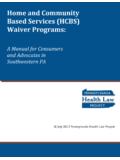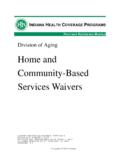Transcription of Myths v. Facts: Californiaʼs Adults with Autism/DD …
1 Myths v. Facts: California s Adults with Autism/DD and the New Medicaid hcbs Rules The federal Medicaid home and community based services ( hcbs ) program helps to fund much of our residential and nonresidential regional center services for Adults with autism and other developmental disabilities ( DDs ). This program is very important because it helps California s Department of Developmental services ( DDS ) fund services in the home and community to those who would otherwise require services at an institutional level of care. The federal Center for Medicaid and Medicare services ( CMS ) recently updated the hcbs rules, emphasizing positive, person-centered outcomes for individuals with developmental disabilities, free from coercion or loss of access to the greater community . They are focused on quality of life and the primacy of choice, dignity, and respect for the hcbs recipients, and are intended to expand choices and opportunities for people with developmental disabilities.
2 The regulations can be found at 42 CFR. Part 430 et seq. States have until March 17, 2019 to implement the requirements for home and community - based settings in accordance with CMS-approved plans. Unfortunately, there has been misunderstanding and misinformation about the rules, with most of the confusion focused on whether hcbs can fund services in settings characterized as congregate, . clustered, or disability-specific. Here, we separate myth from fact . MYTH fact . 1. hcbs mandates The new rules clearly require that inclusion and community access must be inclusion, requires among the options offered to regional center clients as part of the person- full inclusion, and centered planning process. However, the rules do not mandate or requires regional require full inclusion for all consumers. The precise contents of the centers to fund only person-centered plan ( PCP ) depend on the preferences and needs of the services in settings DD individual.
3 As a consequence, the regional centers must respond with a that provide real fuller range of service and program options. inclusion in the general community Specifically, CMS has stated that an individual must have the option to and do not segregate select a setting that is not limited to people with the same or similar types consumers. of disabilities. Clients may receive services with other people who have either the same or similar disabilities, but must have the option to be served in a setting that is not exclusive to people with the same or similar disabilities. hcbs Final Regulations 42 CFR Part 441 Q&A (emphasis added). The language and intent reflect the Supreme Court s Olmstead decision which held that under the Americans with Disabilities Act, individuals with mental disabilities have the right to live in the community , if appropriate and desired, rather than confined by government into institutions.
4 Please sign up for updates at hcbs Myth v fact February 2016 p. 1. MYTH fact . 2. The rules do not CMS has stated: It is not our intention to exclude a state from receiving allow for services [ hcbs funds] for a setting solely based on the fact that it is a congregate provided in setting. Our intention is to specify qualities necessary for a setting to be congegate residential considered a HCB setting. Congregate settings may be included. hcbs . or nonresidential Final Regulations 42 CFR Part 441 Q&A. settings, such as a day program Congregate settings, if desired, should be specified and justified in the specializing in the individual s PCP (in California, the Individualized Program Plan, or IPP). needs of Adults with The rules do not require full inclusion for all clients at all times, but rather autism and similar that programming must support full access to the greater community . 42. DDs.
5 CFR (a)(1) (emphasis added). The rules do not allow hcbs funding for services in settings that are institutional, but they also do not require that a DD adult visit the mall, library, bowling alley, supermarket, theater, restaurant, coffee shop, art museum, barbershop, or anywhere else in the broader community , or that the adult live in a generic apartment or home with majority nondisabled neighbors or housemates, unless desired by the individual. If an individual chooses to spend time living and/or working in conjunction with others with disabilities, rather than in a generic community setting, that congregate setting must support full access to the community to the extent desired and the PCP/IPP must reflect and facilitate that. 3. A client can be Eligibility for services does not hinge on location, geography, or physical denied hcbs funded characteristics of a setting: services based on location, geography The home and community - based setting provisions in this final rule or physical establish a more outcome-oriented definition of home and characteristics of his community - based settings, rather than one based solely on a chosen setting.
6 Setting s location, geography, or physical characteristics.. CMS fact Sheet, CMS 2249-F/2296-F, January 10, 2014, p 1. hcbs rules require a higher scrutiny for settings presumed to have institutional characteristics, including a setting that has the effect of isolating individuals receiving the hcbs waiver from the broader 42 CFR (a)(2)(5). A. CMS subregulatory guidance states that settings that may be considered presumptively isolating include farmsteads or communities that offer all- inclusive housing, day programming, medical, therapeutic, social and recreational activities, with limited, if any, interaction with the broader community . CMS Guidance On Settings That Have The Effect Of Isolating Individuals Receiving hcbs From The Broader community . So long as opportunity for interaction with the broader community is not restricted, these settings should not be presumed isolating under the terms of the new regulations.
7 And in the event they are presumed isolating, that presumption is rebuttable via evidence submitted by stakeholders and community members during a heightened scrutiny process initiated by the state. In support of this position, California s DDS has already stated it would not shut down settings based solely on their location. Federal guidance states that the location alone does not make the setting or the type of service unallowable. DDS hcbs Frequently Asked Questions, p. 3. Please sign up for updates at hcbs Myth v fact February 2016 p. 2. MYTH fact . 4. Disability-specific CMS has stated that the goal of this regulation is not to take services from programs and individuals, or make individuals move from a location where they have housing will lose always lived, but to describe the qualities of settings in which services funding or not be intended to provide an alternative to institutional care may be delivered.
8 Funded. The goal of this regulation is to widen the door of opportunity for individuals receiving Medicaid hcbs to support the same choices to participate in community activities as are available to individuals not receiving Medicaid hcbs ; to have a choice in how, when, and where they receive services ;. and to remove unnecessary barriers and controls. hcbs Final Regulations 42. CFR Part 441 Q&A. In other words, the goal of hcbs is to increase options, not to narrow them: the recipient is empowered to select which options fulfill his or her goals and needs, and a regional center will need to bolster its roster of services to encompass full inclusion. A state does have the authority to assert a setting as non- hcbs compliant if it does not meet the standards set forth in the federal regulations, but the mere fact it may be disability- specific is not among the reasons why it could be ineligible for funding.
9 5. hcbs won t fund The CMS subregulatory guidance offers a certain form of disability-specific services for farm community as an example of residential setting that may have the individuals with effect of isolating people receiving hcbs from the broader community .. autism or DD who The farmsteads contemplated by CMS in this document are described as reside on farms, large, self-contained, and remote, without supporting access to the broader residential community . They are characterized as being located in rural areas, on developments with large parcels of land, offering little ability to access the broader community agricultural features, outside the farm. or rural setting. This example offered by CMS hinges on the question of access to the broader community . As with Myth/ fact #3, such a setting may create a rebuttable presumption of isolation, however so long as opportunity for interaction with the broader community is unrestricted and driven by the individualized terms of the PCP/IPP, these settings should not be presumed isolating (and therefore to not have the qualities of an institution).
10 Under the express terms of the new regulations. In the event they are presumed isolating for some reason, that presumption is rebuttable via evidence submitted by stakeholders and community members. Additionally, a rural setting is compliant with hcbs so long as it does not discourage an individual s integration with the broader community . According to CMS, the determination would not be based on whether the setting was in a rural, urban, or suburban community , but on whether it has the qualities of home and community - based settings as specified in this rule. hcbs Final Regulations 42 CFR Part 441 Q&A. California DDS has already stated that rural settings are not automatically presumed to be isolating. The question is whether individuals with disabilities who receive services in a rural area have the same opportunity for community integration as people without disabilities in that community .



